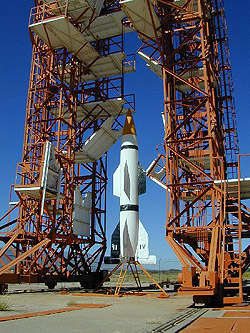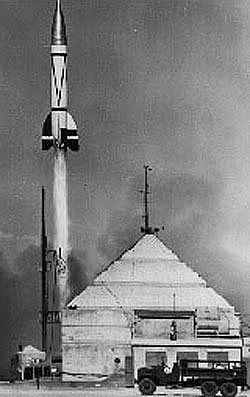
The White Sands V-2 Launching Site, or Launch Complex 33, was developed specifically to accommodate V-2 rocket tests at the White Sands Missile Range in New Mexico. The launch complex has two important structures: the old Army Blockhouse and the launching crane, also known as the Gantry Crane. The Army Blockhouse was completed in late September 1945 and was primarily used as an observation point and laboratory in the pioneer development of the V-2 rocket in the United States. The Gantry Crane, a steel tower 75 feet tall and 25 feet wide, was constructed in November 1946 to launch the V-2 and Viking rockets. The German V-2 Rocket-Vergeltungswaffen-2, or "weapon of retaliation"--the most advanced rocket of its type, was developed to support the German war effort and by 1945 hundreds of these rockets were launched against Allied targets in England and on the continent of Europe. The American government in Operation Paperclip captured more than 100 V-2 rockets and numerous German scientists and engineers associated with the V-2 development program, including Dr. Werner Von Braun. The Army brought Dr. Von Braun and the captured V-2s to the newly opened White Sands Missile Range.
By March 1946 the first captured V-2 was static test fired at White Sands and in April 1946 the first V-2 was launched. From 1946 to 1951 the Army generated an increasing expertise in rocket technology and launched 67 V-2s from White Sands, establishing high altitude and velocity records that reached to the very edge of space. From these experiments emerged the first generation of American built rockets such as the Corporal, Redstone, Nike, Aerobee and Atlas. At the conclusion of the testing program for the V-2, the Army transferred its rocket team under Dr. Von Braun to the Redstone Arsenal in Huntsville, Alabama, to continue work on basic research and prototype development of new rockets. Launch Complex 33 at the White Sands Missile Test Range tested and launched the very first generation of technologically sophisticated rockets that enabled Americans to probe to the very edge of space.

On the White Sands Missile Range the world's first nuclear device (code name "Trinity") was detonated on July 16, 1945. The Los Alamos Project of the Manhattan Engineer District of the War Department began in 1943 with its purpose the development and final manufacture of a nuclear instrument of war. The Trinity Site, within the White Sands Missile Range, is a National Historic Landmark.
Visit the National Park Service Travel American Aviation to learn more about Aviation related Historic Sites.
Last updated: August 29, 2017
